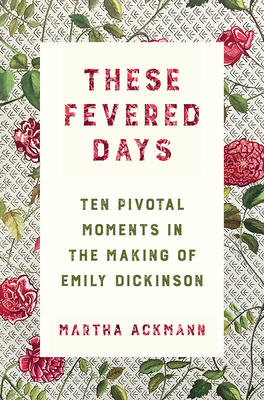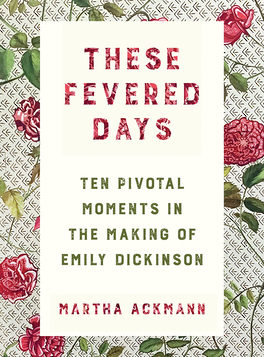 THESE FEVERED DAYS
THESE FEVERED DAYS
Ten Pivotal Moments in the Making of Emily Dickinson
by Martha Ackmann
Norton. 278 pages, $26.95
IN THESE FEVERED DAYS, Martha Ackmann has hit upon an ingenious method for retelling the extraordinarily well-documented yet maddeningly uncertain life of Emily Dickinson. Each of her ten chapters focuses on a significant decision that Dickinson made on a particular day, such as choosing to leave Mount Holyoke Female Academy rather than make the public commitment to Christ as her personal savior as required of all first-year students, or committing her life to writing poetry by daring to respond to an article in The Atlantic Monthly by Thomas Wentworth Higginson, who would become her most valuable reader and an important link to the literary world outside of her narrowly circumscribed Amherst. Because each of these pivotal “moments” necessarily transcends a single day, Ackmann remains free to look backwards and forwards in time. She analyzes the Mt. Holyoke crisis, for example, in terms of Dickinson’s lifelong religious uncertainty and independence of spirit.
Two particular maneuvers help Ackmann to maintain her sharp focus. First, by drawing upon daily meteorological records for Dickinson’s Amherst, she’s able to juxtapose a scientific report of that day’s weather with Dickinson’s extraordinary poems about weather-related events (“I’ll tell you how the Sun rose—/ A Ribbon at a time”). Second, by summarizing newspaper reports of the day’s local happenings, Ackmann is able to contrast the social events that preoccupied Dickinson’s contemporaries—a sale on hats and mufflers at the local dry goods store, the gala dedication of a Civil War cannon in the town square—with the explosive events of the poet’s inner life.
The risk of this method, as Ackmann anticipates in her preface, is that selecting “ten pivotal moments” can easily turn into “a kind of parlor game” played with fellow Dickinson aficionados, inviting us to question the relative importance of these ten moments. Her picks deliver a Dickinson that, like William Luce’s popular portrait of the poet in The Belle of Amherst some 45 years ago, is charming and mischievous, but paint a portrait that ignores the dark undercurrents that make her poems so compelling.
 Paradoxically, even though Dickinson was the author of some of the most erotic poems in English, Ackmann’s narrative offers a relatively sexless reading. And considering the extraordinary scholarship on the same-sex elements of her love poetry ever since the publication of Rebecca Patterson’s groundbreaking The Riddle of Emily Dickinson in 1951, we may wonder how it is possible in 2020 to publish a book that ignores entirely the lesbian implications of Dickinson’s poetry. In 19th-century New England, Dickinson was reduced to fantasizing about, not allowed regularly to enjoy, sexual pleasure with another woman.
Paradoxically, even though Dickinson was the author of some of the most erotic poems in English, Ackmann’s narrative offers a relatively sexless reading. And considering the extraordinary scholarship on the same-sex elements of her love poetry ever since the publication of Rebecca Patterson’s groundbreaking The Riddle of Emily Dickinson in 1951, we may wonder how it is possible in 2020 to publish a book that ignores entirely the lesbian implications of Dickinson’s poetry. In 19th-century New England, Dickinson was reduced to fantasizing about, not allowed regularly to enjoy, sexual pleasure with another woman.
Start with the fact that Dickinson’s most sexually suggestive poems strategically avoid using gender pronouns, making the sex of the addressee indeterminate. “Wild nights—Wild nights!/ Were I with thee/ Wild nights should be/ Our luxury!” exclaims one speaker to an unidentified interlocutor. Significantly, the poem is written in the conditional, specifying only how the speaker would feel if she were allowed to indulge her passionate inclinations toward this unknown person, or how satisfied she would be after a night of wild lovemaking simply to lie in some male or female lover’s arms: “Rowing in Eden—/ Ah—the Sea!/ Might I but moor—tonight—/ In thee!” The suggestion is that the way to regain paradise is not through renunciation of the physical appetites, as a traditional moralist have argued, but through the “luxury” of sensual self-indulgence with her gender-unspecified partner.
Dickinson’s most erotic adventures are ones in which the speaker is unable to act upon her amorous desires. Consider the hesitation of “Come slowly—Eden!” in which the poem’s artfully ambivalent syntax posits the speaker as either “the fainting Bee” that, “Reaching late his flower, / Round her chamber hums—/ Counts his nectars—/ Enters—and is lost in Balms,” or as the blossom excitedly anticipating the bee’s swooning upon entering her fragrant zone. The active agent is rendered passive by sexual excitement, allowing the poem to be read as an anticipation of either heterosexual congress or lesbian cunnilingus. In either case, the speaker is aroused to anticipate what might happen, not what has already occurred. For Dickinson, the excitement lay not in actual climax but in the early stages of arousal in which one is delirious with anticipation.
In a chapter dedicated to one of Dickinson’s most frequently anthologized poems about death, “Safe in their alabaster chambers,” Ackmann contrasts two drafts of the poem that Dickinson shared with her sister-in-law Susan—also her lover, some would argue—in order to demonstrate the frustration that Dickinson experienced when she did reach out to a person whom she trusted. But even the highly intelligent Susan could not absorb what Dickinson was attempting. Thinking that she was advancing the poet’s cause, Susan offered the early, less challenging version of the poem to a local newspaper for publication. Worse, the paper printed the poem with changes to regularize Dickinson’s meter and make her language more palatable to conventional readers. Ackmann’s chapter on the poem is a haunting portrait of the urgency with which Dickinson sought a sympathetic audience, only to be betrayed twice over. What emerges most clearly in Ackmann’s narrative is Dickinson’s unhesitating rejection of advice when it was clear that her audience was not equal to her poem. Dickinson knew what she was doing, the rest of the world be damned!
Ackmann’s “ten pivotal moments” are, finally, so selective that the author proves to be like the museum docent who carefully steers her charges past the more challenging and controversial artwork to those pieces that she is certain will offend no one. Her book suffers, finally, from what Dickinson herself dismissed as the “Dimity convictions” of those “Soft—Cherubic Creatures” that the poet considered Amherst’s “Gentlewomen” to be. In her desire to produce a Dickinson who is palatable to a general readership, Ackmann strategically avoids those pivotal moments when Dickinson boldly puts on display her “freckled Human Nature”—that is, her exploration of her deepest desires and fears.
Ackmann’s tight focus reveals in sharp detail certain parts of Dickinson’s life and work. Unfortunately, it also reminds us of the damage done to the larger picture by such a myopic view. I find it difficult to believe that not one of Ackmann’s “ten pivotal moments” should reveal anything about the poet who wrote “Wild Nights” and “Come Slowly—Eden!”
Raymond-Jean Frontain is professor of English at the Univ. of Central Arkansas, where he teaches a course on Dickinson’s poetry.






